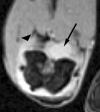Molecular characterization of rheumatoid arthritis with magnetic resonance imaging
- PMID: 22648081
- PMCID: PMC3387734
- DOI: 10.1097/RMR.0b013e31825c062c
Molecular characterization of rheumatoid arthritis with magnetic resonance imaging
Abstract
Several recent advances in the field of magnetic resonance imaging (MRI) may transform the detection and monitoring of rheumatoid arthritis (RA). These advances depict both anatomic and molecular alterations from RA. Previous techniques could detect specific end products of metabolism in vitro or were limited to providing anatomic information. This review focuses on the novel molecular imaging techniques of hyperpolarized carbon-13 MRI, MRI with iron-labeled probes, and fusion of MRI with positron emission tomography. These new imaging approaches go beyond the anatomic description of RA and lend new information into the status of this disease by giving molecular information.
Figures





Similar articles
-
Screening for peptides targeted to IL-7Rα for molecular imaging of rheumatoid arthritis synovium.Arthritis Res Ther. 2016 Oct 12;18(1):230. doi: 10.1186/s13075-016-1133-8. Arthritis Res Ther. 2016. PMID: 27729062 Free PMC article.
-
Detection of subclinical synovitis with macrophage targeting and positron emission tomography in patients with rheumatoid arthritis without clinical arthritis.J Rheumatol. 2014 Nov;41(11):2145-52. doi: 10.3899/jrheum.140059. Epub 2014 Oct 1. J Rheumatol. 2014. PMID: 25274888
-
Macrophages mediated diagnosis of rheumatoid arthritis using fibrin based magnetic nanoparticles as MRI contrast agents.Biochim Biophys Acta Gen Subj. 2017 Jan;1861(1 Pt A):2992-3001. doi: 10.1016/j.bbagen.2016.09.018. Epub 2016 Sep 20. Biochim Biophys Acta Gen Subj. 2017. PMID: 27663233
-
Emerging optical and nuclear medicine imaging methods in rheumatoid arthritis.Nat Rev Rheumatol. 2012 Dec;8(12):719-28. doi: 10.1038/nrrheum.2012.148. Epub 2012 Sep 25. Nat Rev Rheumatol. 2012. PMID: 23007740 Review.
-
Ultrasound versus high field magnetic resonance imaging in rheumatoid arthritis.Clin Exp Rheumatol. 2014 Jan-Feb;32(1 Suppl 80):S99-105. Epub 2014 Feb 17. Clin Exp Rheumatol. 2014. PMID: 24528508 Review.
Cited by
-
Focusing on ligamentous soft tissue inflammation for the future understanding of early axial psoriatic arthritis.Rheumatology (Oxford). 2024 Dec 1;63(Supplement_2):ii7-ii14. doi: 10.1093/rheumatology/keae568. Rheumatology (Oxford). 2024. PMID: 39700474 Free PMC article. Review.
-
Advancing musculoskeletal research with nanoscience.Nat Rev Rheumatol. 2013 Oct;9(10):614-23. doi: 10.1038/nrrheum.2013.112. Epub 2013 Jul 23. Nat Rev Rheumatol. 2013. PMID: 23881069 Review.
-
In vivo quantification of mouse autoimmune arthritis by PET/CT.Int J Rheum Dis. 2016 May;19(5):452-8. doi: 10.1111/1756-185X.12410. Epub 2014 Jun 26. Int J Rheum Dis. 2016. PMID: 24965561 Free PMC article.
-
Hyperpolarized 13 C magnetic resonance imaging for noninvasive assessment of tissue inflammation.NMR Biomed. 2021 Mar;34(3):e4460. doi: 10.1002/nbm.4460. Epub 2020 Dec 8. NMR Biomed. 2021. PMID: 33291188 Free PMC article. Review.
-
EXPLORing Arthritis with Total-body Positron Emission Tomography.Semin Musculoskelet Radiol. 2023 Dec;27(6):632-640. doi: 10.1055/s-0043-1775746. Epub 2023 Nov 7. Semin Musculoskelet Radiol. 2023. PMID: 37935209 Free PMC article. Review.
References
-
- MacKenzie JD, Karasick D. Imaging of Rheumatoid Arthritis. In: Weissman B, editor. Imaging of Arthritis and Metabolic Bone Disease. Elsevier Health Sciences; Philadelphia: 2009. pp. 340–64.
-
- Sommer OJ, Kladosek A, Weiler V, Czembirek H, Boeck M, Stiskal M. Rheumatoid Arthritis: A Practical Guide to State-of-the-Art Imaging, Image Interpretation, and Clinical Implications1. Radiographics. 2005;25:381–98. - PubMed
-
- McQueen FM, Ostergaard M. Established rheumatoid arthritis - new imaging modalities. Best Pract Res Clin Rheumatol. 2007;21:841–56. - PubMed
-
- Scott DL, Kingsley GH. Tumor necrosis factor inhibitors for rheumatoid arthritis. N Engl J Med. 2006;355:704–12. - PubMed
-
- Felson DT, Anderson JJ, Boers M, et al. American College of Rheumatology. Preliminary definition of improvement in rheumatoid arthritis. Arthritis Rheum. 1995;38:727–35. - PubMed
Publication types
MeSH terms
Substances
Grants and funding
LinkOut - more resources
Full Text Sources
Medical

